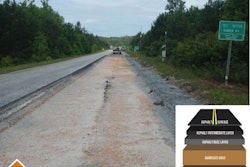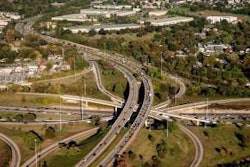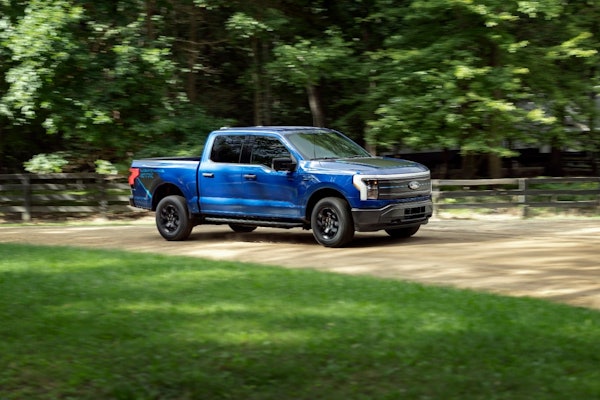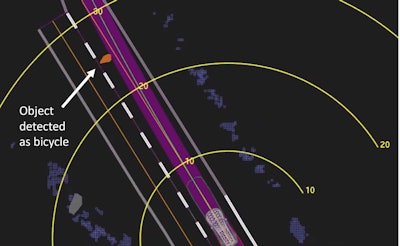 This Uber self-driving system data playback from the fatal March 18 crash of an Uber Technologies test vehicle in Tempe, Arizona, shows when, at 1.3 seconds before impact, the system determined emergency braking was needed to mitigate a collision. (The yellow bands depict meters ahead of the vehicle, the orange lines show the center of mapped travel lanes. The purple area shows the path of the vehicle and the green line depicts the center of that path.) Source: NTSB.
This Uber self-driving system data playback from the fatal March 18 crash of an Uber Technologies test vehicle in Tempe, Arizona, shows when, at 1.3 seconds before impact, the system determined emergency braking was needed to mitigate a collision. (The yellow bands depict meters ahead of the vehicle, the orange lines show the center of mapped travel lanes. The purple area shows the path of the vehicle and the green line depicts the center of that path.) Source: NTSB.
The Uber operator whose self-driving car killed a pedestrian in Tempe, Arizona, last March was “relied on” for braking in any emergency – especially given that an automatic emergency braking system was shut off. That’s according to a new federal report that lays the blame more on the driver than the car.
The report says that when her Uber test car was in computer mode, its factory-equipped automatic emergency braking system was disabled.
Beyond that, the car’s system is not designed to alert the driver of the impending collision, according to the preliminary report by the National Transportation Safety Board (NTSB) on the accident that killed a 49-year-old woman March 18.
About 10 p.m. that Sunday night, an operator in an autonomous car sat behind the wheel but not steering. The car hit the homeless woman as she pushed a bicycle across a street, 360 feet south of the nearest crosswalk. Toxicology tests found methamphetamine and marijuana in her system, the NTSB says in its May 24 report.
At 1.3 seconds before impact, the report says, the test car’s self-driving system determined that emergency braking was needed to mitigate a collision. But that didn’t happen because the braking system was shut off.
“According to Uber, emergency braking maneuvers are not enabled while the vehicle is under computer control to reduce the potential for erratic vehicle behavior.” the report says. “The vehicle operator is relied on to intervene and take action. The system is not designed to alert the operator.”
The collision was reported as the first death involving an autonomous vehicle, dealing a blow to the industry.
Now, testing of Uber’s driverless vehicles is set to resume in the coming weeks amid signs the industry weathered the blow. Among those: the preliminary report’s indication that any driver would have found it difficult, perhaps unavoidable, to avoid this nighttime collision, especially with no alert beforehand.
Factory-equipped automatic emergency braking was disabled
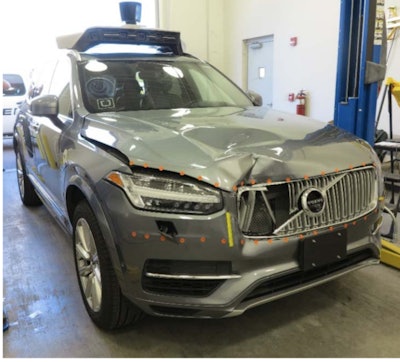 The test vehicle, showing damage to the right front, was photographed after the fatal collision with a pedestrian pushing a bicycle outside a crosswalk in Tempe, Arizona the night of March 18.
The test vehicle, showing damage to the right front, was photographed after the fatal collision with a pedestrian pushing a bicycle outside a crosswalk in Tempe, Arizona the night of March 18.
According to the report:
“The vehicle was factory-equipped with several advanced driver assistance functions by the original manufacturer Volvo Cars, including a collision avoidance function with automatic emergency braking as well as functions for detecting driver alertness and road sign information.
“The Volvo functions are disabled only when the test vehicle is operated in computer control mode.”
The National Transportation Safety Board released this information in its preliminary report for the ongoing investigation of the fatal crash involving the pedestrian and the Uber Technologies, Inc., test vehicle.
Just before the accident that Sunday night, the operator placed her modified 2017 Volvo XC90 in the self-driving system’s computer control mode.
She was traveling in the right ‘through’ lane when her car’s right front side struck the woman. The vehicle operator was not injured.
From early on, to local police it looked like Uber would not be held responsible for the accident caused by a victim that had without warning entered the road from shadows.
The pedestrian was “dressed in dark clothing, did not look in the direction of the vehicle until just before impact, and crossed the road in a section not directly illuminated by lighting,” the NTSB report says.
Victim Elaine Herzberg, known as “Elle” and “Ms. Elle,” had been widely liked throughout the homeless community of Tempe, Arizona, a suburb of Phoenix, Reuters reported on March 20.
Details released by NTSB; testing of driverless cars to resume
Uber temporarily halted its testing program after the tragedy. Now, the company is planning to resume operations this summer. Those details are still being finalized, a spokeswoman tells Equipment World.
The vehicle operator has told NTSB that she had been monitoring the self-driving interface and that while her personal and business phones were in the vehicle, neither were in use until after the crash.
Here are some of its findings of the NTSB report, which doesn’t find cause:
The pedestrian was pushing a bicycle that did not have side reflectors. Its front and rear reflectors, along with the forward headlamp, were perpendicular to the path of the oncoming vehicle.
The woman entered the roadway from a brick median, where signs facing toward the roadway warn pedestrians to use a crosswalk, which is located 360 feet north of the Mill Avenue crash site.
Uber had equipped this test vehicle with a developmental, self-driving system. It had forward- and side-facing cameras, radars, Light Detection and Ranging, navigation sensors and a computing and data storage unit integrated into the vehicle.
The report states data obtained from the self-driving system shows the system first registered radar and LIDAR observations of the pedestrian about six seconds before impact, when the vehicle was traveling 43 mph.
“As the vehicle and pedestrian paths converged, the self-driving system software classified the pedestrian as an unknown object, as a vehicle, and then as a bicycle with varying expectations of future travel path,” the report says.
The self-driving system data showed the vehicle operator engaged the steering wheel less than a second before impact and began braking less than a second after impact.
“All aspects of the self-driving system were operating normally at the time of the crash, and there were no faults or diagnostic messages,” the report says.
The NTSB says it “continues to gather information on the Uber self-driving system, the vehicle interface, the vehicle operator’s personal and business cell phones, the vehicle operator, the pedestrian and the roadway.”.
The Uber vehicle was part of the company’s self-driving fleet of vehicles. The investigation will address the vehicle’s interaction with the environment, other vehicles and vulnerable road users such as pedestrians and bicyclists.
The preliminary report could change as the NTSB’s ongoing investigation progresses, the agency says.


